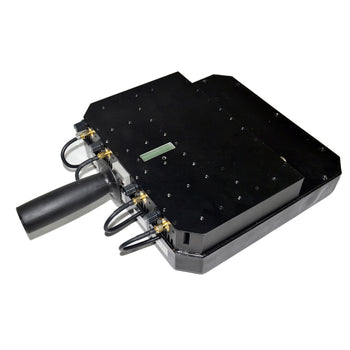GPS Malfunction for Navigation Warfare
In the report Navigation Warfare in Troop Service 12/2017, Vice Lieutenant Herbert Kröll explains the possible dangers of partial or complete GPS signal failure and its effects on military and civilian applications.
The requirement for sufficiently accurate position fixing, navigation and time setting is an essential prerequisite for the use of most weapon systems. This can only be guaranteed by a working navigation system. The target of navigation warfare is the interference of satellite position, navigation, and time information by an enemy.
Navigation systems or GNSS (Global Navigation Satellite System) now cover the entire globe. They are used to determine position and navigate on land, at sea and in the air by receiving signals from navigation satellites and pseudolites (terrestrial transmitters, such as satellites, that emit signals).
Initially designed as a military system for weapon systems, warships or combat aircraft for global positioning, now they have become useful for everyone. The first satellite was launched in 1978 and was not officially put into service until 1995. Meanwhile, the Russian “GLONASS”, Chinese “COMPASS” or IRNSS covering only India are also in service. Europe has been building its own system under the name “Galileo” for years. See also TD booklet 2/2017 (#356).
The term GPS includes only the American system "NAVSTAR-GPS" (navigation system using timing and telemetry - Global Positioning System). This world-wide system is the best known and is also used by the military in Europe. The GPS system is therefore much more important for navigational warfare than the European Galileo.
Feature
For an accurate determination of the gps position, several satellite signals are required.
With GPS, the location of the receiving antenna on Earth is determined by measuring the distance to several satellites orbiting 20,000 kilometers around the Earth. A single satellite is not enough to determine the position; further distance measurements with other satellites are required. Only the spherical radiation from three satellite signals results in an intersection that allows an exact location to be determined.
However, the satellite signal propagates differently in the vacuum of space than after entering the Earth's atmosphere. The signal delay time must therefore also be taken into account, otherwise measurement errors of several meters will result. To enable distance measurement, the time of the GPS system at the time of transmission is encoded in the satellite signal. Since the receiver clock is initially not exactly synchronized with GPS time, this difference is used as an additional unknown when determining location. To determine the three initially unknown location coordinates and a time constant, the distance to a fourth satellite is needed. This means that the exact location on the Earth's surface can be calculated by calculating three local equations and an equation of time.
GPS satellite navigation
Satellite navigation systems basically consist of room, floor and user segments. In the case of GPS, the space segment consists of 24 active satellites and seven spare satellites, which orbit the Earth in six orbits, each with four satellites, at an altitude of approximately 20,200 kilometers. For civilian use, the L1 frequency is transmitted at 1575.42 MHz, for military use the encryptable L2 frequency is used at 1227.60 MHz. The L designation indicates the L band from 1000 to 2000 MHz. Navigation data and standard code (C/A code) are sent on the civilian frequency, and encrypted, not publicly known precision code (P code) is sent on the military frequency.
Each of these two signals consists of the carrier wave, code and navigation data, with each signal satellite informing the receiver of its orbital data and the time the signal was transmitted. In order to distinguish which satellite the signal comes from, a special modulation method is used for the GPS signal, which allows the simultaneous transmission of several data streams in a frequency range. This means that each satellite can be distinguished by its code sequence.
Modern GPS receivers can determine the distance to the satellite with an accuracy of 2.93 m using the standard code. The encrypted P/Y code with a ten times higher chip rate is used for exclusively military purposes. This allows an accuracy of about 30 cm when measuring the distance to the satellite. As of May 2, 2000, artificial tampering with satellite-transmitted time (S/A, Selective Availability), which resulted in inaccurate position determination for civilian GPS receivers, has been disabled until further notice. Current positioning standards include Standard Positioning Service (SPS) for civilian use and Precise Positioning Service (PPS) for military use. Navigation Warfare will further increase the security standard.
Due to the limited power supply, the transmit power of GPS satellites is similar to that of television satellites and is approximately 50 watts. The wide bandwidth of the receiver for both frequencies and the unknown direction of the transmitter cause a high noise component, so that the wanted signals are lost in the noise. The signal must therefore be multiplied by the receiver's own code sequence to make it stand out from the noise again. In addition, interference due to multipath propagation of detour signals reflected from the surrounding area may occur. Proper antenna installation location and shielding can reduce this, however.

GPS jammer
With a jammer, the GPS signal can usually be blocked or blocked successfully. Since the GPS signal for navigation only touches the earth very weakly, only a weak interference signal is needed to disrupt navigation systems on the ground. Even a small GPS jammer can interfere with the signal within ten meters. You can find enough plans for this on the internet. This means that the localization of vehicles equipped with a GPS receiver is no longer possible and that the navigation system is no longer functional.
What can be remedied by simply looking at a map in the case of pure navigation can have significant consequences in the case of military systems that depend on accurate position, navigation and time information. As a result, communication systems could no longer exchange data with each other in a network-centric operation. Weapon systems that obtain their data from many sensors and rely on the timing information of the GPS signal would no longer be usable.
Navigation War
Space times like sunstorms can navigate through navigation systems and make it temporary.
Preventing your opponent from using GPS or at least restricting their access to GPS data is now part of successful warfare. Ultimately, it can greatly reduce the enemy's weapon effect. Navigational warfare can be waged in different ways and either by disrupting (removing) or deceiving (imitating) a satellite signal. Possible consequences are self-harm, collateral damage, and leadership issues. Since the GPS signal or the signal of other navigation systems can be used by everyone in an operational area, the personal risk in Navigation Warfare must always be considered. In the future, railways and light rail vehicles will be controlled by satellite navigation, which would save signaling systems along the route. These sections of the route are already being tested. The cars could also be driverless in the future. The navigation war would therefore also have an impact on the use of navigation systems in public spaces and for everyone.
Navigation Warfare Possibilities
Interference (noise / interference)
Navigation content can no longer be filtered out by sending an interference signal on the GPS carrier frequency, as there is no or only poor reception.
Deception (impersonation, repetition, measurement)
Here an available signal is modified, broadcast with a delay or newly generated. The goal is to trick adversary systems, which depend on position, navigation and time information.
Identity theft
Identity theft is the targeted manipulation of data. Existing signals can be tampered with or incorrect signals can be generated in order to convey misleading position, navigation and time information to the adversary. Either a satellite signal containing false information is artificially modified, or technically correct signals are redirected. The GPS receiver receives this signal as an actual message and processes the incorrect information, resulting in incorrect position or time information. Weapon systems are limited in their effectiveness or aircraft and ships are off course.
Repeat
Here an original satellite signal is recorded and time shifted and/or retransmitted with higher power. This also results in incorrect position or time information.
Meaconing
The measure is the deliberate misleading of a user by an artificially generated satellite signal with incorrect information. However, the benefits are offset by a very high technical expense. To disturb the user, a target tracker and a GPS signal simulator are needed to generate the pseudo signal. The biggest challenge is the perfect real-time signal replication, since military codes are not usually known. Therefore, civilian GPS receivers with known codes are more at risk.
Protection measures against navigational warfare
Les voitures de l'avenir peuvent toujours être plus fortes dépendant des systèmes de navigation. cela propose des risques de sécurité.
As with electronic warfare, protective measures must also be taken when navigating. All military users of receiver systems that rely on satellite position, navigation, and time information should be made more aware of the risks associated with civilian GPS receivers or unencrypted military GPS receivers. Essentially, these protective measures rely on the use of military GPS receivers with a current cryptographic key and the use of special antenna technology.
military code
The military code (M code) is a future military GPS signal. It was developed as "jamming" protection to provide secure military access to GPS. In order to be able to receive the transmitted frequency of 5115 MHz, separate receivers are required. The military code is transmitted by the satellite in the respective operational area. This increases the signal strength by 20 dB, which means the signal reaches the earth's surface about 100 times stronger than before. In order to achieve a sufficient interference effect, much more powerful and therefore larger jammers should be built.
Antenna technology
Antennas that have an appropriate characteristic to suppress interfering signals can render interfering signals ineffective. They dampen signals that come “from below” or have a small elevation. The installation of so-called "choke rings" is technically less demanding. Specially shaped metal rings are attached around the GPS receiving antenna. Signals below a horizontal angle determined by the design are suppressed or at least attenuated. Additional protection is provided by multi-element antennas (CRPA protection, Controlled Reception Pattern Antenna), which consist of several GPS antennas and an electronic evaluation unit. By electronically weighting the reception patterns of the individual antennas, an interfering signal can be recognized and a zero can be formed in the direction of the interfering transmitter. Interfering signals from this direction are suppressed. Multiple deletion is also possible with this technique.
Due to their weight, space and power requirements, and especially due to their high price, phased array antennas can only be used on large platforms. CRPA protection is not currently suitable for use in a portable receiver.
A future protective measure could be "beam steering, forming antennas". These reception antennas form "lobes" which follow only the satellites used. Signals from other directions are neither received nor suppressed. This technology is currently being tested, but is not yet ready for mass production. The best, but also the most expensive, protection measure currently is multi-sensor technology (MTS). A central navigation system not only uses satellite-generated position, time, and navigation information, but also receives additional navigation data from other independent systems. The independent input signals are additionally "strengthened" by "Kalman filtering", which significantly increases resistance to interference. At the moment, this technology is only available for large weapon systems such as ships, planes, vehicles, etc.
Perspective
An F-18 (left) accompanies the unmanned X-45 drone. USES THE X-45 GPS FOR NAVIGATION.
GPS and other position, navigation and time systems used worldwide for military and/or civilian purposes will continue to be determined by military tasks in the future. The previous disadvantage of civilian use was that only the L1 carrier frequency was available for it. Due to modernization, the L2 carrier frequency is now also available for civilian use to eliminate range errors due to ionospheric influences. A third additional frequency with carrier L5 must also be created.
The higher military requirements lead to an increase in signals in number and information content without putting the civil service at a disadvantage. The P/Y code previously sent exclusively for military purposes will remain for some time. With the introduction of the new military M-Code, advanced GPS receivers are being used. This increases protection against GPS interference and safety in military use of GPS signals, because the military M code signal is far from other codes. Interference with the civil code therefore has no influence on the signal of the military M code.
Navigation is very important in the world, both civil and military. GPS and equivalent systems are an inexpensive component available worldwide. Civil receivers in particular are more easily disturbed and also more easily misled. Simulators are available on the market for everyone. Therefore, navigational warfare is becoming increasingly important. Soldiers who use position, navigation and time information must therefore be specially trained. It also means that the good old card can still be read in order to remain operational in the event of a system failure or deception.
Vice Lieutenant Herbert Kröll is the main teacher of electronic warfare and the FASAN simulation system at the leadership support school.













